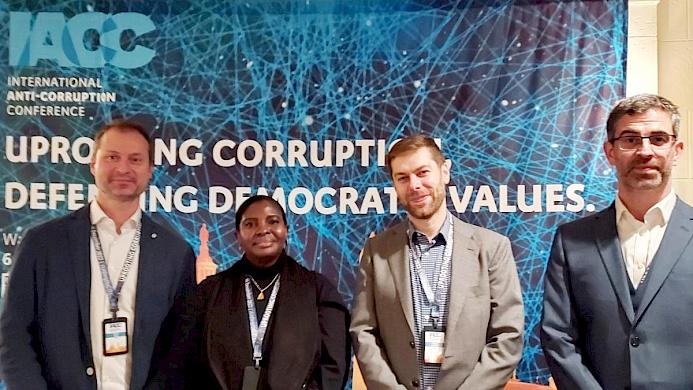
Ben Brock
Senior Wildlife Crime Analyst
Motivating action against corruption-enabled Environmental Crime at IACC
2022 was my first visit and TRAFFIC’s first time hosting a panel at the world’s largest anti-corruption conference, the IACC.
As a conservationist, I wasn’t sure how mainstream the illegal wildlife trade and environmental crime would be to the wider counter-corruption audience. This fear proved unfounded. From the outset, our panels were welcomed by attentive and engaged audiences, and the majority of other attendees already understood the threat to the natural world from corruption.
This diversity of knowledge allowed the scale of discussions to range from vast international development programs to the personal – including the emotional announcement of a land rights defender murdered on the first day of the conference. This scale demonstrated that the threat of corruption is present, personal and pervasive.
Despite the range of organisations aligned against corruption, the sheer volume of well-documented examples of government bribery and illegal destruction of the natural world for corporate gain left me feeling we are the underdog in this fight.
While the threats are grave and imminent, the seriousness of corruption-enabled environmental destruction motivates action and cooperation across sectors and between countries.
This cross-sectoral approach was a crucial element in TRAFFIC’s panel:
“How to Engage the Finance Industry in the Fight Against Cross-Border Corruption: Tackling Money Laundering in the Wildlife Crime Setting."

Alongside these, the conference explored mitigations and solutions already underway in two key areas, transparency and accountability.
Transparency
Corruption is a crime that not only flourishes in secrecy, it requires it to function. Anything that illuminates and enables scrutiny reduces the opportunity, especially for illegal abuse of natural resources. The IACC clearly articulates a suite of tools, techniques and legislation that can deliver this:
Beneficial Ownership registers were at the forefront of many panels as an essential step to reduce shell companies and other corporate vehicles that enable the movement of criminal assets around the world and conceal who may be behind destructive or illegal practices. Transparency of financial benefit also enables civil society to detect possible corruption, such as the recent Targeting Natural Resource Corruption project.
Whistleblowers have a powerful impact in the fight against corruption – from the large-scale Panama Papers to individual company behaviour, as revealed in the Fishrot Scandal. These individuals can reveal assets and activities that would otherwise be hidden from scrutiny. However, they must be protected in legislation for them to step forward with confidence.
Investigative Journalists were widely discussed as a method to uncover the vulnerability of corrupt actors. There were numerous examples of tenacious and persistent reporters that have dragged environmentally destructive practices into the public eye. Sadly, the conference also showed the vulnerability of these journalists and the protection they need to be able to do their work. This message was brought home with profound sincerity by Matthew Caruana Galizia, the son of the Maltese journalist Daphne Anne Caruana Galizia, who was killed by a car bomb while reporting on government corruption, nepotism, and allegations of money laundering.
Visibility is essential to identify corruption, but it is only half of the solution; there needs to be a response to these crimes when they are revealed, which can include accountability.
Accountability
Being able to identify and track those who benefit from criminal activity is essential mitigation, but we also need to be able to hold individuals and organisations accountable. There has to be a response to illegal activity to stop criminals from benefitting from their crime and to act as a strong preventative measure.
Many laws that were initially focused on individual criminality – such as anti-money laundering legislation – struggle to be applied to corporate entities that diffuse management responsibility across trans-continental supply chains. So it’s encouraging to see new legislation which can be applied:
Directive on corporate sustainability due diligence, the aim of this European Union Directive (enacted 2022) is to drive sustainable and responsible corporate behaviour and to anchor human rights and environmental considerations in companies’ operations and corporate governance. The new rules will ensure businesses face the adverse impacts of their destructive actions, including in their supply chains inside and outside Europe. While potentially powerful, Member States will be given two years to transpose the EU Directive into their national legislation.
Follow-the-money and Financial Investigation, while corruption is not exclusively financially driven, it does play an important role. When we look at international environmental crime and natural resource corruption specifically, these crimes are almost exclusively conducted for financial gain. Pursuing the illicit financial flows both attacks the motivation for these crimes and the ability to use this money to facilitate corruption.
Commercial supply chain accountability, unlike illegal ivory and rhino horn trafficking, which remain illegal markets throughout their supply chain, the most valuable assets, fish and timber, generate tens of billions of dollars annually from being sold in legitimate commercial outlets. Focusing on timber, there is existing legislation in the US, the Lacey Act, and in Europe, the EU Timber Regulations, which both push the responsibility for mitigating the risk of corrupted supply chains onto the companies which profit at the point of sale to the public – but these responsibilities are rarely scrutinised. These businesses must be held accountable by their customers, financial providers and investors.
In summary, the threat from natural resource corruption and environmental crime is profound and severe, but tools to tackle this threat do exist; however, it will only be by widely applying the mitigations throughout the criminal supply chains they will be effective. Those seeking to stop corruption and protect the natural world will have to use data from many sources, across multiple sectors, throughout international supply chains, using various techniques and legislation. The good news is that it is possible, and possibly we stand at the turning of the tide.


